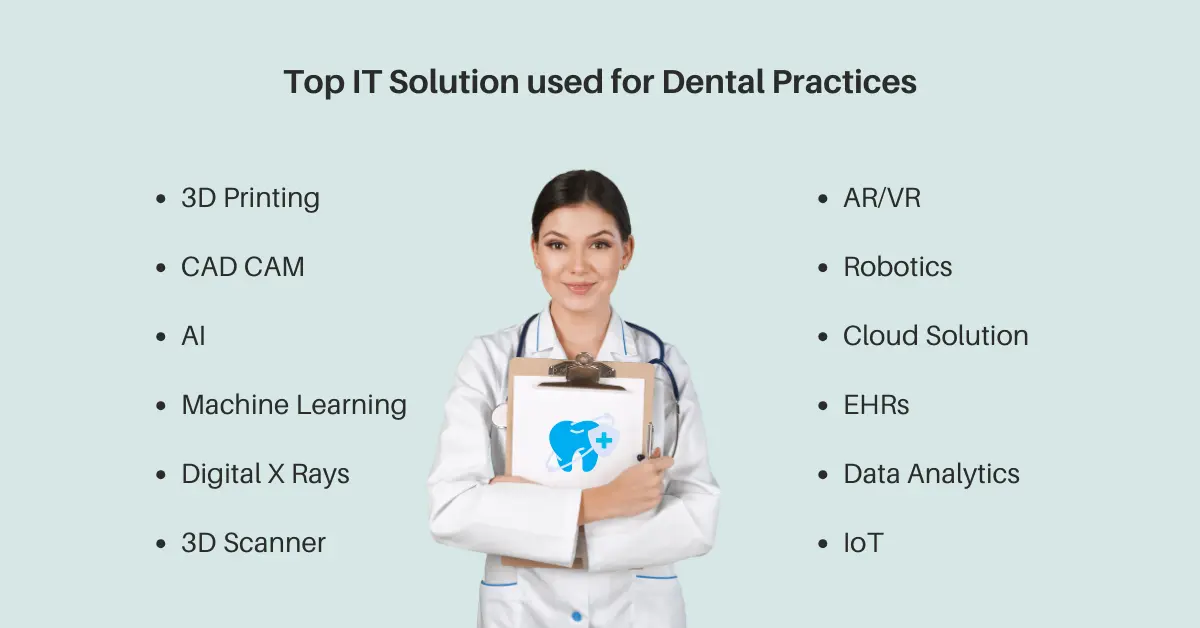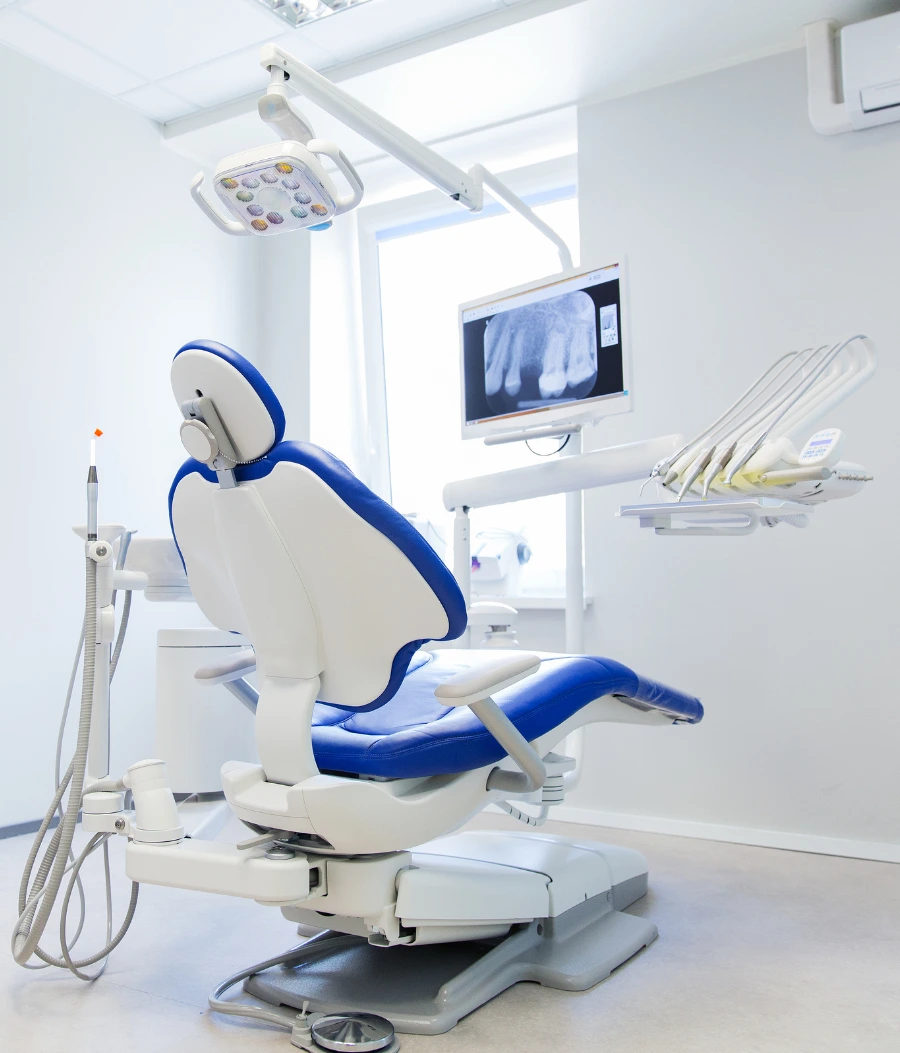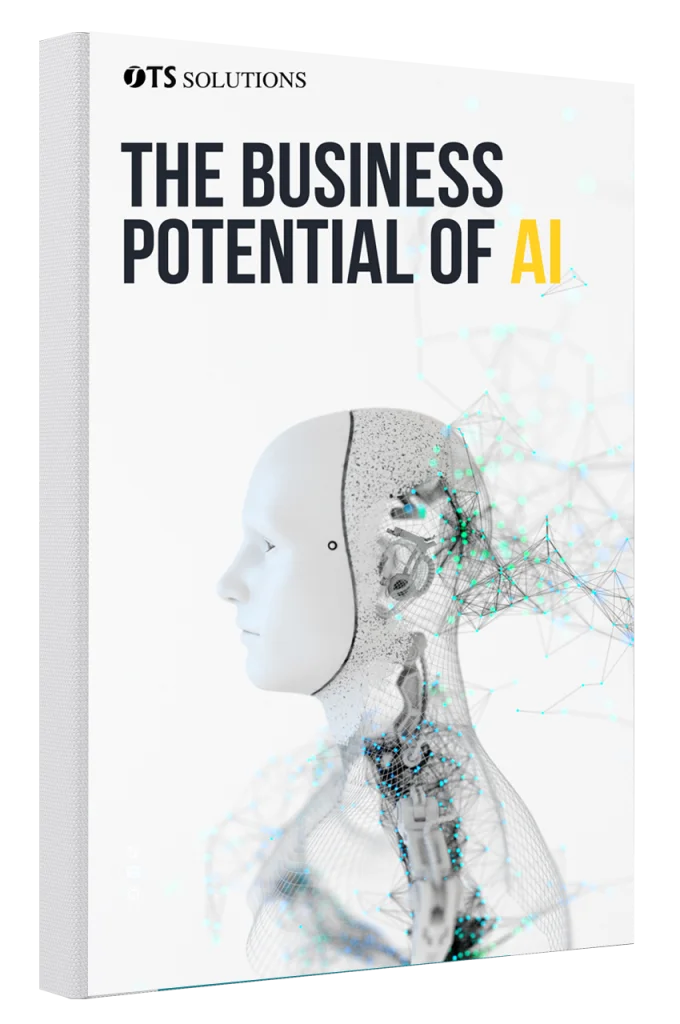How does Digital Technology help build the Next Generation of Dental Practices?
Introduction to the Digital Transformation for Dental Practices
Dental practices are transforming as digital technology is reshaping oral healthcare. From streamlined workflows to enhanced patient experiences, digital IT services and tools are revolutionizing the next generation of dental practices.
In this article, we explore how digital technology is helping to advance dental care, improve efficiency, and empower dental professionals and patients alike. By embracing digital innovation, dental practices can achieve higher precision, convenience, and overall success in providing quality oral healthcare.
Understanding the Shift towards Digital Technology
How is the Dental industry Adopting New Technologies?
Digital technology has become an integral part of dental practices. From improved diagnostics to streamlined workflows, digital tools are revolutionizing dentists’ operations.
Dentists are increasingly adopting digital technologies in their practices due to its benefits. There are many reasons why dentists are shifting towards digital IT solutions, but in this blog, we discuss the top 2 reasons why dental practices are adopting digital solutions so fast.
Reason 1: Improved Accuracy and Precision
Traditional methods are prone to errors and inaccuracies. With the adoption of digital technologies, dentists can now take highly accurate and detailed 3D impressions. Additionally, digital technologies allow for better communication with dental laboratories, as the digital models can be easily shared and transferred, reducing the chances of miscommunication, and resulting in better-fitting restorations
Reason 2: Improved Patient Experiences
Modern technologies enhance patients’ comfort & reduce the time required for the procedure. Digital technologies enable dentists to create virtual treatment plans, allowing patients to visualize the expected outcomes of their dental treatments and make informed decisions.
Moreover, they offer numerous benefits and open exciting possibilities to enhance patient care and experiences. Let us discuss them in the section below.
Key Benefits of Digital Technology in Dental Practices
1. Improved accuracy and efficiency in diagnostics
Digital technology enables dentists to obtain highly accurate and detailed diagnostic information. Digital imaging techniques, such as cone beam computed tomography (CBCT), provide three-dimensional views of patients’ oral structures. It allows for precise treatment planning and enhanced patient outcomes.
2. Enhanced treatment planning and case presentation
With digital tools, dentists can create virtual treatment plans & send them to patients. Through computer-aided design and computer-aided manufacturing (CAD/CAM) technology, dentists can design and fabricate restorations on-site, reducing the need for multiple visits.
3. Optimized patient communication and engagement
Digital technology strengthens the bond between dental practices and patients. Online platforms facilitate communication, allowing patients to schedule appointments, ask questions, and receive updates conveniently. Additionally, digital tools such as intraoral cameras enable dentists to share real-time images and educate patients about oral health issues.
4. Virtual consultations and online appointment scheduling
Digital technology offers the convenience of virtual consultations, enabling patients to discuss their concerns and receive initial advice without visiting the dental office. Online appointment scheduling further streamlines the process, eliminating phone calls and allowing patients to choose a suitable time.
5. Personalized patient education and treatment simulations
Digital tools provide an interactive and personalized approach to patient education. Animated videos and treatment simulations help patients understand complex procedures, making them active participants in their oral health journey. It enhances treatment acceptance and empowers patients to make informed decisions.
6. Automated reminders and follow-up systems
Keeping track of appointments and following up with patients is made easier with automated reminders and follow-up systems. These digital tools ensure that patients stay on top of their oral health and avoid missed appointments. They also foster a positive patient-practice relationship, showing that the practice values their time and health.
7. Streamlining dental workflows with digital technology
Digital records management eliminates the need for extensive physical paperwork, reducing clutter and saving time. Storing patient records electronically also enhances data security and enables easy access for authorized personnel. Dental imaging technology makes capturing, analyzing, and storing radiographic images more efficient and reliable.
8. Integration of practice management software and tools
Digital technology integrates various practice management tools, including appointment scheduling, billing, and patient communication, into a cohesive system. This streamlines administrative tasks, improves office efficiency, and reduces errors, allowing dental professionals to focus on delivering quality care.
9. Efficient inventory management and ordering systems
Digital technology simplifies inventory management, ensuring that dental practices always have the necessary supplies. It facilitates automated ordering systems and real-time inventory tracking. Moreover, it also saves time and money while ensuring smooth operations.
10. Improving patient outcomes through predictive analytics
Predictive analytics is transforming the way dental practices approach patient care. By analyzing historical data, predictive analytics algorithms can identify patterns and predict potential oral health issues before they become severe. From detecting early signs of oral cancer to predicting the risk of dental complications, predictive analytics is a meaningful change in dental practice.
11. Timesaving
Digital solutions significantly save time for dental professionals with the advancement of technology. Digital tools like electronic health records (EHRs), digital X-rays, and appointment scheduling software help dentists access patient records instantly, store and analyze radiographs efficiently, and manage appointments seamlessly.
12. Patient Engagement
With the integration of digital technologies and the latest features such as online
appointment scheduling, tele-dentistry, and patient portals, dentists are now able to conveniently connect with their patients and improve accessibility to dental services.
13. Space-Saving
By incorporating digital solutions, there is no need to use multiple machines. Dental professionals can optimize their workspace more efficiently and save valuable physical space. One such example is X-rays, X-rays no longer require physical film, eliminating the need for cumbersome filing cabinets and storage rooms.
Challenges in the Adoption of Digital Technology in Dental Clinics
Challenge 1: Overhead Costing in Dental Practices
Investing in digital equipment and systems can be expensive. The initial investment required for purchasing digital imaging systems, software, and other technology can put a strain on the practice’s budget. Furthermore, ongoing maintenance and upgrade expenses add to the financial burden. While the long-term benefits may outweigh the costs, many dental professionals find it challenging to justify the expenditure.
How to overcome?
Costs, implementation, and training are key considerations. Research is one of the best strategies for reducing the overhead costs of digital solutions. It is essential to conduct thorough research and comparison of various digital solutions available in the market. It is crucial to consider the long-term financial benefits that digital solutions, such as enhanced efficiency, improved patient care, and increased revenue, can justify the initial investment.
Challenge 2: Addressing Privacy and Security Concerns
As with any digital technology, privacy and security concerns are paramount. Dental practices must ensure that patient data is properly protected and complies with privacy regulations. Implementing robust data encryption, access controls, and secure data storage systems are essential steps to safeguard patient information and maintain trust.
How to overcome?
Digital solutions come with robust security measures, such as encryption, firewalls, and secure data storage systems with data protection regulations and standards, such as HIPAA, which is essential. Regular staff training on data security protocols and strict access controls can further safeguard patient data in the digital era.
Challenge 3: Ensuring Compatibility and Interoperability of Digital Systems
Compatibility issues can lead to frustration and inefficiency in dental practices. Instead of enjoying the benefits of a fully integrated digital ecosystem, practitioners may find themselves wasting time and effort on manual workarounds.
How to overcome?
In a rapidly advancing digital landscape, ensuring the compatibility and interoperability of different digital systems is crucial. Dental practices must choose technologies that seamlessly integrate with their existing infrastructure and allow for smooth data exchange. Interoperability ensures efficient workflows, reduces manual data entry, and prevents data silos that hinder effective dental practice management.
Prospects and Trends in the Digitalization of Dental Practices

1. Advancements in Augmented Reality and virtual reality applications
The future of dental practices is likely to feature advancements in augmented reality (AR) and virtual reality (VR) applications. These applications can be used to enhance patient education, simulate treatment outcomes, and improve the overall dental experience.
2. The potential of robotics in dental procedures
Robotic technology is already making waves in various fields, and dentistry is no exception. Robotics can assist dentists in performing precise and complex procedures, improving accuracy, and reducing the risk of human error.
3. AI in Risk Assessment and Treatment Planning
AI in dentistry is revolutionizing risk assessment and treatment planning in dental practices. AI-powered systems can assist in treatment planning by suggesting the most suitable procedures based on individual patient characteristics.
4. Machine Learning and Real-time Analysis
Machine learning algorithms can detect patterns and make accurate predictions, fostering early detection and diagnosis of oral diseases. These algorithms support dental professionals in improving their decision-making processes by providing real-time guidance during complex procedures.
Machine learning enables personalized treatment plans by analyzing patient records and historical data, optimizing dental care outcomes.
5. Advancements in 3D Printing Technology
Advancements in 3D printing technology have revolutionized the field of dentistry, offering enhanced precision, efficiency, and customization in various dental procedures. 3D printing enables dental professionals to deliver personalized treatment plans that cater to each patient’s unique dental needs.
6. Cad-Cam Dentistry, Digital Impression Systems
Digital solutions in Cad Cam dentistry have revolutionized the dental industry by providing an innovative and efficient approach to various dental treatments. CAD-CAM machines fabricate dental restorations with exceptional precision and speed.
7. Dental Practice Management Software
Dental practice management software allows medical professionals to focus more on delivering quality patient care. Moreover, this software provides seamless integration between different departments within the clinic, facilitating better communication and coordination among the dental team.
Cloud-based Dental Software
Dental professionals can easily schedule appointments, store patient records, manage billing and insurance claims, and access their practice’s data from any device with dental software. Moreover, these software systems act as a tool to optimize their processes, enhance patient care, and stay at the forefront of the digital age.
8. Electronic health records (EHRs)
With EHR, dental practitioners can easily access and update patient information. In this way, it enhances efficiency and accuracy in diagnoses and treatments. These digital solutions contribute to improved data management, enabling better research and analysis opportunities for dental advancements.
9. Tele dentistry / Telehealth Solutions
Through telehealth digital solutions, dentists can remotely diagnose oral conditions, prescribe medications, and provide oral health education to patients, ensuring continuity of care and promoting preventive measures. These digital solutions have increased access to dental care and costs and improved overall patient satisfaction.
10. IoT and Improved Patient Care
IoT-enabled devices such as smart toothbrushes, dental implants, and diagnostic tools equipped with sensors are providing valuable data to both dentists and patients. This real-time information allows for more accurate diagnoses, personalized treatment plans, and improved patient care.
Additionally, IoT devices are improving efficiency in dental clinics by automating certain tasks, such as appointment scheduling and inventory management.
11. Data Analytics for Dentistry
Data analytics is crucial in dentistry as it enables dentists and dental professionals to gain valuable insights from large volumes of data. By analyzing patient records, treatment outcomes, and other dental data, dentists can identify patterns, trends, and correlations that can help improve diagnosis, treatment plans, and overall patient care.
12. Digital X rays
Unlike traditional X-rays, digital X-rays use electronic sensors to capture images, eliminating the need for film development. The digital format also facilitates easy storage and sharing of patient records, improving communication and collaboration between dental professionals.
13. Intraoral Camera
The Intraoral Camera assists in better communication between the dentist and the patient. It also enhances patient education by allowing them to see the areas of concern firsthand. With its ability to identify dental issues in their initial stages, the Intraoral Camera is crucial in promoting preventive care and improving overall oral health outcomes.
14. 3D Scanner
3D Scanner can produce 3D models within minutes. Dentists can now offer patients faster and more precise treatments by reducing the need for uncomfortable physical impressions and increasing overall patient satisfaction. Furthermore, the integration of 3D scanners in dentistry has also enabled enhanced communication between dental professionals.
How can OTS Solutions be your go-to partner to digitally transform your Dental Practices?
OTS Solutions can play a vital role in providing digital dentistry solutions. With our expertise in Digital Transformation and Engineering services, we can create customized digital platforms and overall practice management. OTS Solutions can provide Digital IT solutions to streamline administrative tasks & enhance communication between dental professionals, patients, and insurance companies. OTS Solutions can effectively transform the dental industry by making it more digitized, accessible, and patient-centric.
Conclusion:
In this blog, we discussed how Digital IT Solutions can change the Dentistry industry.
We can conclude that dental professionals can streamline workflows, improve diagnostics, enhance patient experiences, and stay at the forefront of dental innovation. Moreover, you can connect with us if you are hunting for the best Dental IT services provider for your next project.
Revolutionize Your Dental IT Infrastructure Today
Ready for a digital transformation in your dental practice? Our IT services ensure a seamless integration of technology, offering reliability, security, and improved patient care. Let’s take your practice to the next level.
Frequently Asked Questions:
Q1. What financial benefits can dental practices expect from IT integration?
Ans) Some of the financial benefits.
It allows for efficient management of patient records, appointments, and billing, reducing administrative costs and improving workflow.
With digital imaging and electronic health records, dentists can store and retrieve patient data easily, eliminating the need for manual paper-based systems.
Furthermore, electronic claims processing and online payment options simplify billing processes, accelerating cash flows, and reducing overhead expenses.
Q 2) How much does it cost to implement digital dental solutions?
Ans) The cost depends on what kind of solution dental practices may need. We start by assessing the gaps and innovation potential of making dental practices more digitally equipped for the future.
Q 3) How do I get my team on board with transitioning to modern technologies?
Ans) It is crucial to communicate the benefits of modern technologies, highlighting how it can streamline processes, improve efficiency, and enhance productivity for the team. Additionally, involving the team in the decision-making process can foster a sense of ownership and collaboration.
Q 4) Why is there resistance to the adoption of digital technology in dentistry?
Ans) Resistance to change is a common challenge faced by dental professionals when it comes to adopting digital technology. Dentists may be reluctant to move away from traditional methods, fear that technology will replace the human touch, or lack motivation to invest time and effort in learning new systems.








